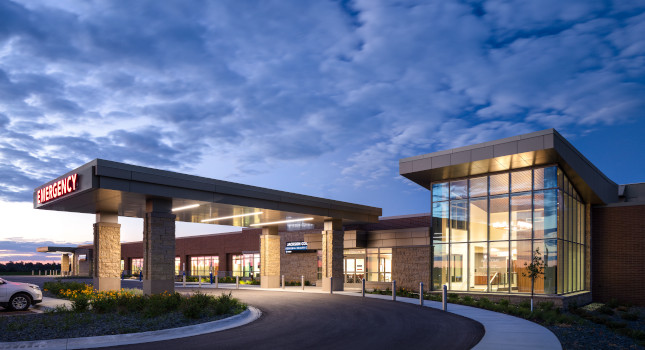Learn about the basic concepts of emergency preparedness planning — a vital component of a health care facility’s overall resiliency — and the role of the consulting engineer

Learning Objectives
- Understand health care resiliency and the four major risks faced by health care facilities.
- Identify the components of the CMS Emergency Preparedness Rule.
- List the five steps in a health care emergency preparedness plan.
- Discover how the consulting engineer can assist in an emergency preparedness plan.
We expect health care institutions and their providers to always be available in our times of need — regardless of inclement weather, natural disaster, a worldwide pandemic, active shooter event, power loss, infrastructure failure or any number of additional emergencies.
Being able to meet this expectation of uninterrupted care, however, is no small feat and requires health care institutions to conduct extensive emergency preparedness planning, training and testing. This is the only means by which they can ensure they are prepared for the wide range of scenarios that could threaten their ability to provide continuous care and service.
The depth and reach of the potential risks to health care facilities can be overwhelming. One only need recall disastrous events from 2021 — the cold weather and resulting brownouts in Texas, the wildfires in Colorado, the EF4 tornado in Kentucky and the 45 million people affected by cybersecurity breaches at health care institutions — for a short list of real-life events that can test nearby health care facilities’ resiliency.
To address this concern, the risks to health care facilities are placed into four risk categories:
- Natural disaster.
- Infrastructure.
- Hazardous materials.
- Human-made events.
Regardless of the type of risk, achieving resilience begins and ends with a comprehensive emergency preparedness plan (see Figure 1).

Why an emergency preparedness plan is needed
Benjamin Franklin said, “If you fail to prepare, prepare to fail.” This certainly rings true for health care institutions and what can likely happen in the absence of a comprehensive emergency preparedness plan. Having a well-thought-out emergency plan is not only a good idea, it is also required by the federal government for most health care facilities.
The Centers for Medicare & Medicaid Services requires health care institutions who receive reimbursements to comply with the Emergency Preparedness (EP) Rule, implemented in November 2017. The EP Rule covers four main components:
- Emergency plan and hazard vulnerability assessment (HVA): Uses an integrated team to develop a comprehensive emergency plan based upon a site-specific risk assessment.
- Policies and procedures: Identifies the internal policies and procedures that the facility and all departments intend to deploy during various types of emergencies.
- Communication plan: Establishes the internal and external communication plan the health care institution intends to deploy during an emergency. This plan often includes members of the local community including law enforcement, fire departments and governmental entities.
- Training and testing: Requires health care facilities to test their emergency plan annually with a combination of a full-scale exercise and tabletop session.
Of the four core components of the EP Rule, consulting engineers will have the largest involvement and greatest impact on the emergency plan and HVA. This component can be completed in parallel with a major health care renovation or expansion, as part of a greenfield design or simply as a yearly validation process.
For most major threats to a health care facility, a component of mitigation before and during an event will include hardening some type of building infrastructure — HVAC pressurization, fuel storage capacity, redundant electrical feed, off-site data center, etc. Therefore, it is important for the consulting engineer to understand how a health care facility’s emergency plan is developed and how to contribute to it. To aid in this understanding, following is a step-by-step process that is used by most health care institutions.
Health care emergency plan process
By implementing the following steps, the consulting engineer can effectively address a multitude of risks in a health care building design:
Step 1: Assessment
Oftentimes a health care organization will establish an assessment team to address a very particular risk and then stack the team with subject matter experts on that specific risk. For example, when evaluating a health care organization’s risk for a cyberattack, an organization may establish a team consisting of the CIO, information technology leadership, engineering and an outside security software vendor to lead the emergency planning efforts.
Different risks obviously require a different assessment team makeup. In addition, such teams benefit from having a diverse group that includes not only technical experts but also clinicians with an operational perspective. For example, for a recent emergency planning exercise focusing on patient surge, the assessment team consisted of the hospital’s chief nursing officer, CIP, facilities staff, architect, mechanical engineer, electrical engineer, security staff and contractor.
In all risk assessments, emergency preparedness planning deals not only with prevention, but should consist of before, during and after emergency planning components (see Figure 2).

Step 2: Threat analysis
In this step, the assessment team conducts the HVA. The vulnerability analysis defines the severity of the risk, which incorporates the likelihood, the magnitude and the mitigation efforts associated with the risk. Key criteria to evaluate for many events includes the impact to building occupants, the building itself and the ability for the organization to maintain business operations.
Using a qualitative tool is beneficial to the process. Many such tools are available, but a preferred tool by many organizations is the Kaiser Permanente Hazard Vulnerability Analysis Tool (see Figure 3).

Step 3: Gap analysis
During the gap analysis, the assessment team will try to identify holes between their assumed response scenarios and actual response conditions. This is also often referred to as identifying the blind spots in a facility’s operation.
For example, the quantity of on-site fuel storage for emergency power generation is often analyzed during a gap analysis. For most locations, NFPA 99: Health Care Facilities Code dictates the code minimum for on-site fuel storage for health care facilities, but whether this is 48 or 96 hours of fuel capacity, the limitation of this key infrastructure needs to be coordinated with the operational intent of the facility. Solutions to expand fuel capacity include pre-negotiated fuel service contracts or electrical load shedding,
Step 4: Cost analysis
The previous steps will help the identification of risks and development of options on mitigation. Options for mitigation could range from minor changes in internal communication plans to major options that consider compartmentalized air handling units with 100% outside air capability.
Most planning exercises will develop several options, but it is not economically feasible to spend financial resources on each disaster scenario. The cost analysis step looks at the combination of the likelihood of the risk, the additional cost required to mitigate or reduce the risk and the cost should the risk occur with the worst-case impact. Taking these three items into account allows the health care organization to make an informed financial decision.
Step 5: Testing and implementation
The final step in the process is to conduct internal testing to evaluate the effectiveness of the health care organization’s emergency preparedness plan.
Inpatient facilities are required by the CMS EP Rule to perform one full-scale exercise and at least one other exercise of their emergency preparedness plan each year. The additional exercise is often a table-top session in which several stakeholders work through an emergency event. The team walks through the before, during and after scenarios and makes modifications as need.

System specification
Health care engineers are well versed in the code requirements for health care facilities and the high level of attention required on major infrastructure for life safety and continuous operation. This includes requirements for essential electrical systems, N+1 heating, mass notification systems, etc. However, a health care facility’s comprehensive emergency preparedness plan is often deemed as scope or responsibility outside of design.
At a minimum, consulting engineers have an obligation to ask their health care clients how their designs will impact the organization’s current emergency plan and encourage a review that involves several members across the organization.
Though no facility wants to undergo a worst-case scenario, emergency preparedness can help health care clients mitigate the impact of an incident, allowing them to continue delivering quality care to their patients and protecting employees and the community at large.
Additional resources also may help the design team:
- FGI Emergency Preparedness White Paper
- Federal Emergency Management Agency Gap Analysis Program Guidance Document.
IMEG is a CFE Media content partner.




